The ASUS ZenPad S (Z580CA) Review
by Brandon Chester on August 31, 2015 8:00 AM ESTDisplay: Stock Settings
I often say that a smartphone is just a display you interact with, which makes the need for a high quality screen paramount. This is even more true for tablets, which are quite literally large touchscreen displays that the user interacts with. With tablet displays having peaked in terms of resolution for the time being, manufacturers are now turning their attention toward color accuracy. Flagship devices like Samsung's Galaxy Tab S tablets and Apple's full sized iPads feature displays with an exceptional level of color accuracy, while smaller or less expensive tablets are more hit-and-miss.
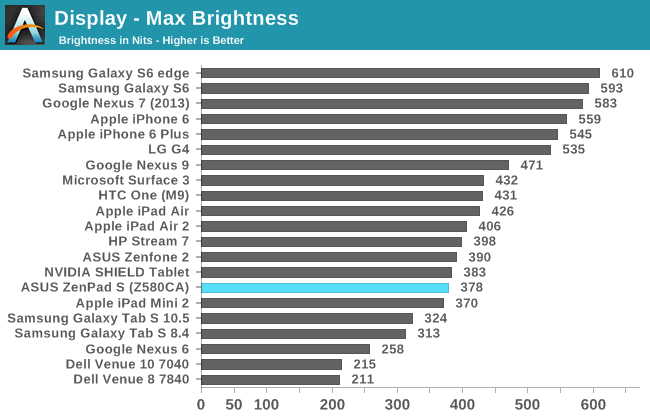

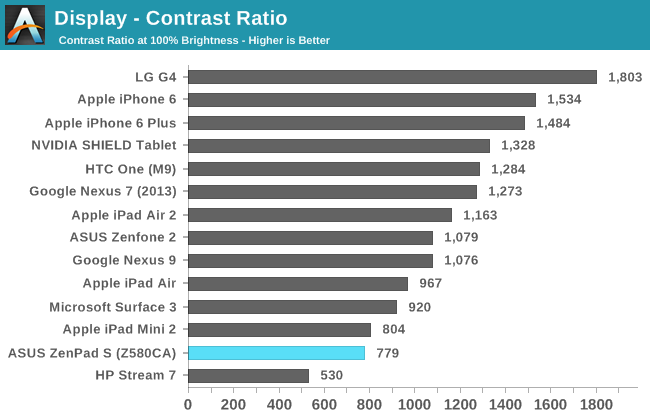
Unsurprisingly, the ZenPad's display is very similar to that of the iPad Mini 2 as far as brightness, black level, and contrast are concerned. While Apple has decided to round 7.85" to 7.9", and ASUS has decided to round to 8.0", I'm fairly confident both devices are using the same LCD technology with different backlight arrays. It should be noted that while the contrast ratio is similar in our measurements, when there is ambient light there will be a much more significant drop in contrast on the iPad Mini 2 due to its unlaminated display.
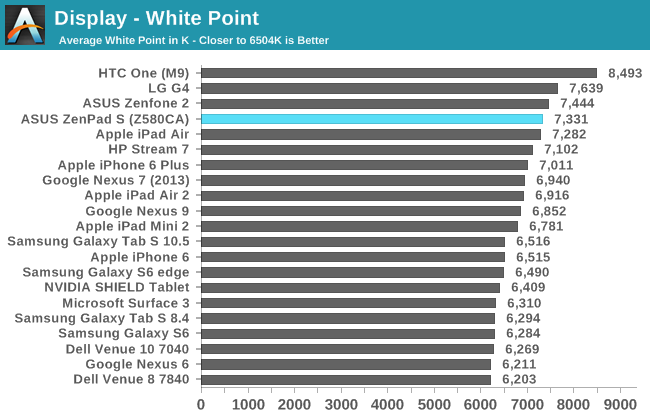
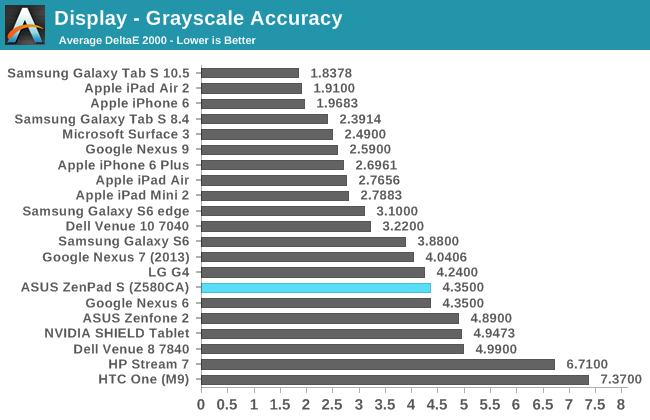
Even if two devices use the same display panel, the color characteristics of each can vary significantly depending on the level of calibration, as well as the spectral range of the LED backlight used. Apple’s iPad Mini 2 achieves a level of greyscale accuracy where errors can only be seen in static content, and is good enough for editing photos and videos without concerns about the accuracy of the images. The ZenPad S doesn’t do as well, with a significant blue shift to most shades of grey. This is also reflected in the display’s high average white point of 7331K. While the ZenPad S doesn’t cost as much as an iPad Air 2 or a Galaxy Tab S2, the Z580CA’s price of $299 is exactly the same as the iPad Mini 2. With that in mind, it’s concerning to see such a gap between the greyscale performance of the ZenPad S and the iPad Mini 2.
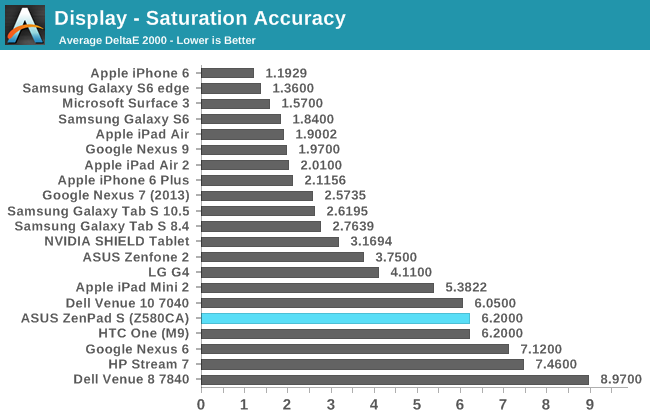
Saturation accuracy on the ZenPad S is much lower than what could be achieved with more attention paid to the display’s calibration. With a DeltaE average of 6.2, the ZenPad S is actually less accurate with rendering primary and secondary colors than the iPad Mini 2, despite the latter having a backlight array that only allows for narrow coverage of the blue and red parts of the sRGB gamut. The spectral range of the LEDs in the ZenPad S almost covers the entire sRGB gamut, but the panel undershoots significantly with reds, overshoots with blue beyond 60% saturation, and has various levels of inaccuracy with yellow, cyan, and most of all, magenta. I was really excited to see that the ZenPad S doesn’t suffer from the narrow gamut of the iPad Mini 2, but I was let down when I realized that the accuracy of primary and secondary colors was actually worse than the iPad due to inadequate calibration.
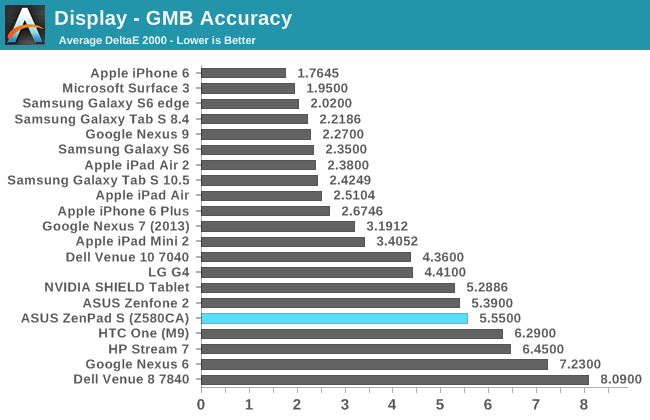
Accurately reproducing color mixtures requires a reasonably accurate gamma, RGB balance for grey shades, and accurate saturations. Gamma on the ZenPad S is reasonably accurate for a mobile device, but the way the display tends toward blue coupled with the inaccurate saturations results in inaccurate color mixtures as well. The ZenPad’s average DeltaE of 5.55 doesn’t compare favorably with the iPad Mini 2’s DeltaE of 3.4 which is imperfect but still fairly accurate. The reason that the iPad Mini 2 ends up being more accurate is because while it cannot be accurate outside its native gamut, within the section of sRGB that it does cover it is very accurate.
As far as the default display configuration of the ZenPad S goes, I’m not exactly thrilled. While it does have a wider gamut than the iPad Mini 3, it ends up being less accurate in every respect due to issues with rendering primary and secondary colors, and a blue shift in the greyscale. Surprisingly, the ZenPad S having a fully laminated display has done nothing to reduce black levels and increase contrast ratio when compared to the non-laminated iPad Mini 2 display, which is an additional disappointment. However, ASUS does provide a few settings to tweak the display, and so hope is not lost.


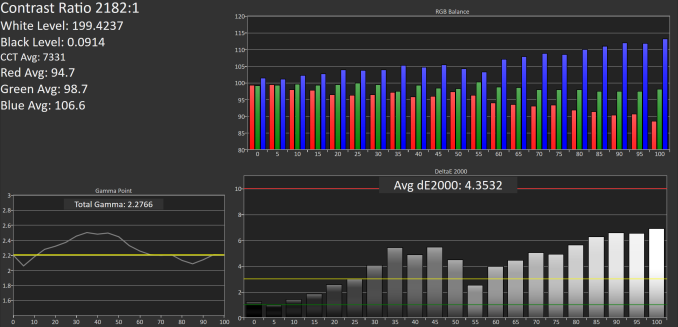

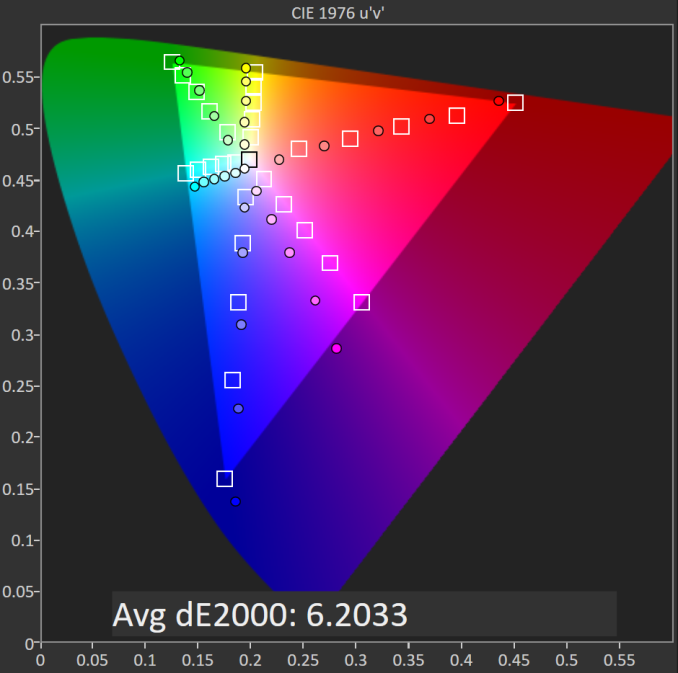









114 Comments
View All Comments
MrSavage - Monday, August 31, 2015 - link
Aside from possibly mentioning the stylus support in the review. I would imagine with that logic, you would assume the S Pen is no biggie when it comes to the Samsung Note. Like just a passing point. It's not like the note taking is a selling point (a big one at that) of the Note series. But in this tablet review, your readers wouldn't even know it existed. I guess you decide on what's the responsible way of reporting on a product.Kepe - Monday, August 31, 2015 - link
The difference is that a Galaxy Note always comes with the pen. How could you review something you don't have? If ASUS had sent him the stylus, he would've written about it. You can't possibly assume that a review mentions every optional extra there is available for a device. "Oooh, your laptop review sucks because you didn't mention the carrying bag or the Kensington lock available for that laptop!!"MrSavage - Monday, August 31, 2015 - link
Friend, again, the point is what? A stylus is a BIG VALUE ADD. No? I give you the example of the Samsung Note to prove that it's a big selling point. To have that feature in the Z580CA yet not have it mentioned it actually irresponsible. You speak of it like it's some smart case that wasn't available at the time of publishing. Optional extra? LOL. List 8-inch tablet with stylus support. Then narrow that list down to similarly priced tablets. None? Right. Leave it out of the review because stylus is just so meh. You are dazzled by charts and graphs that compare apple with oranges and are willing to see a graph to make a determination on screen quality rather than going into a store and looking for yourself.Kepe - Monday, August 31, 2015 - link
omg. Now you're saying a stylus doesn't add value to the product. Then why are you crying about stylus support not being mentioned in the review?And the thing with screen quality is that it is all about accurate color reproduction. So if there is a faintly red flower in a photo, it should look faintly red on your display. If it looks like a hot super bright red flower on a display, then that display is not accurate and isn't good. Even if it makes some things "look" better. Samsung Galaxy S3 for example. Pictures look super pretty on its display. You know why? The display oversaturates everything, and as such it is actually not accurate and not a good display. If you personally like to look at oversaturated things, then buy the SGS3, no one is stopping you. BUT the fact still remains that the display isn't accurate. This was of course just an example. Some things can't be quantified by just looking at it or feeling it somehow.
And this is my last reply to you. Hope ASUS pays you well. Have a good night with your mediocre, badly made tablet. Thanks to the review, I will look elsewhere if and when I need a new tablet.
superflex - Monday, August 31, 2015 - link
Is ASUS paying you in Hot Pockets?You're a pretty poor troll.
MrSavage - Monday, August 31, 2015 - link
@superflex if you care to debate any of the points I'm making, go ahead. I likely know more about the product than most, so I'm going to inform people and hope that people with a large audience will be responsible. If for nothing more than being professional. Like I said, you think I'm wrong about anything I've said in the comments, please advise me. I have a thick skin. People might have learned that the Z580CA has stylus support, so to say that makes me a troll? I only take issue with unprofessional.Winterblade - Monday, August 31, 2015 - link
Is just sad that everyone just forgot another great alternative, the Xperia Tablet Compact, too sad it came dead on arrival due it's high price, I actually found one in clearance for about $230 USD and could not be happier, the build quality is superb, the performance is too, it was even updated to 5.1.1 within the first few hours I had it. If only Sony had managed to sell it for around 300-350 I think it would have been a very very good alternative for people that like mid sized tablets. BTW, the Z3 have an aluminum frame AND is lighter AND thinner than the Zenpad so... it is posible to achieve a lighter device without going full plastic.DanNeely - Monday, August 31, 2015 - link
Sony has a negligible presence in the US market; and their longstanding refusal to provide review samples more or less guarantees their largely being ignored by the US tech press.They make above average hardware; but it doesn't matter to me. I'll be carrying my grudge against them over the rootkit to the grave.
et20 - Monday, August 31, 2015 - link
Thank you for the review.This tablet looked interesting and there's nothing like an Anandtech review to clarify things.
I was interested in the cheaper model so I had proportionately low expectations, but the poor screen calibration is a deal breaker. Too bad.
MonkeyPaw - Monday, August 31, 2015 - link
As a bit of feedback, I think better pictures of the products are needed in these reviews. As I look at these photos, I just can't help but think of someone awkwardly holding a tablet out with one hand while trying to photograph it with the other. I know not everyone is a photographer, but good, clean, properly lit product shots go a long way for a professional look. Make a little product photo booth out of white paperboard/foamcore and mount a camera on a tripod for flashless photography.